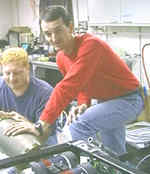| |
Participant
Interview:
Chris
Meinig
Engineer
NOAA/PMEL Engineering
Development Div.
Jeff: What are your responsibilities
on NeMO 2000?
Chris: As an engineer, I make sure the equipment we've brought out from
PMEL works properly and gets safely into the water. I also troubleshoot
and fix anything that breaks down. Some of the equipment on this cruise
includes the vent fluid sampler, the extensometers we've deployed, an
array of temperature loggers, and bottom pressure recorders. We're replacing
the old NeMO
Net camera with a new one attached to a surface mooring (buoy). NeMO
2000 is equipment intensive but not uncharacteristic of a NOAA Vents type
of cruise.
Jeff: How did you end up
working as an engineer for PMEL?
Chris: During graduate school I sold skis at REI. A guy came in and I
asked him about his job because he was wearing a uniform. He said, "We
go out to see. We fly helicopters and airplanes. We go to the North Pole
and South Pole." His job sounded interesting. So, I drove a NOAA ship
for 2 years and then found out about the PMEL lab. They offered me a job
and I've now been with the lab for 10 years.
Jeff: What do you like
most about your job?
Chris: You're involved in projects from start to finish. You can dream
up an instrument, write up a proposal to fund it, build some prototypes
in the shop, test them out, then bring your working instrument into the
field and watch go into the water. There's an adrenaline factor because
if it fails, you're right there in front of it. It's disappointing. However,
if it works, fantastic! You actually see it work. I think it's rare in
this day and age. Most designers and engineers are removed from using
their products.
Jeff: Do the scientists
come to you and say, "Hey, we need something that can do X?"
Chris: Yes. We've taken a science-driven approach. The researcher comes
into the lab and we kick ideas back and forth. We generate a design, come
up with a prototype, then take it to sea and see if it works. I'm really
fortunate to have a really talented and fun group of people to work with.
|
|

Chris Meinig preparing the
bottom pressure recorder (BPR) for deployment.

BPR being deployed from Ron Brown.
|
|

